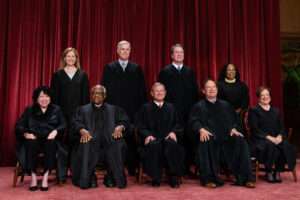The Volokh Conspiracy
Mostly law professors | Sometimes contrarian | Often libertarian | Always independent
A Modest Revelation About Trump v. Anderson
Recent New York Times reporting about the Court's deliberations on the case modestly reinforces the view that the Court ruled that disqualification from office-holding under Section 3 requires congressional legislation.

Today's much-discussed New York Times article by Jodi Kantor and Adam Liptak includes many details about the inner workings of the Supreme Court's deliberations on several key cases decided this year. For the most part, I think the revelations aren't enormously surprising. Chief Justice John Roberts maneuvered for consensus on some key cases. But, in two important ones involving Trump - Trump v. Anderson (the Section 3 disqualification case) and Trump v. United States (the presidential immunity case) - he ultimately sided with a bloc of four conservative justices when full consensus proved elusive. That is fairly evident from the opinions in the cases themselves.
But the reporting does shed a little light on one issue regarding Trump v. Anderson. In my forthcoming article criticizing that ruling, I argue that the majority ruled that people can only be disqualified from holding office under Section 3 of Fourteenth Amendment pursuant to special congressional legislation under Section 5 of the same Amendment (which gives Congress the power to enact "appropriate" enforcement legislation). In legal parlance, they held that Section 3 is not "self-executing." That is also what the concurring opinions by Justice Amy Coney Barrett and the three liberal justices assume (both opinions differ with the majority on that issue). But some other commentators - most notably Will Baude and Michael Paulsen - disagree, arguing that majority only concluded that states cannot disqualify a candidate like Trump.
The New York Times article suggested the justices themselves interpret the ruling much as I do:
While all nine justices agreed that Mr. Trump should remain on state ballots, four of the conservatives were pushing to go beyond that and rule that the Constitution's prohibition would require congressional action to take effect. Such a decision would provide greater protection for Mr. Trump: To prevent him from taking office if he won re-election, Congress would have to vote to enforce the insurrectionist ban.
That left the chief justice in control of the outcome. He lingered over the choice, those familiar with the process said. Ultimately, he sided with the four conservatives in an opinion that he wrote but that was issued unsigned [emphasis added]. Justice Amy Coney Barrett and the three liberals wrote concurrences saying the majority had gone too far.
Although the judgment was 9 to 0, the justices had not reached true agreement.
If Kantor and Liptak's sources are accurate, four conservative justices (Alito, Gorsuch, Kavanaugh, and Thomas) wanted a ruling holding that congressional legislation is required and Roberts ultimately "sided" with them. If so, that means all nine justices interpret the ruling as requiring such legislation (we know Barrett and the liberals did, based on what they say in their concurring opinions).
Various caveats apply. Most obviously, it is the text of the ruling that is binding, not the subjective intentions of the justices who joined it. Perhaps the majority justices intended to rule that Section 3 isn't self-executing, but failed to actually incorporate that idea in the opinion. In my view, the text of the opinion points in the same direction (see pp. 327 of my draft article); but it's not completely definitive. In addition, it's possible that Kantor and Liptak's sources are somehow dissembling or misinformed.
Still, if the story is correct, the revelation has some significance, because it may prefigure what the Court would do if Section 3 disqualification issues come before it again.
Ultimately, the big flaws in the Court's decision are that the majority reached a poorly reasoned decision on self-execution, and all nine justices greatly overstated the threat posed by a "patchwork" of state rulings on disqualification, while ignoring the danger of allowing insurrectionists to return to power - especially to the most powerful office in the land. I go into these and other issues in greater detail in my article. Because that article will officially be in print tomorrow, it's too late for me to incorporate the New York Times revelation. But I don't think it would alter any of my conclusions.
The excellent Baude-Paulsen critique of the Court's ruling also was posted too late for me to consider it in my own article. I agree with most of their criticisms of the decision, but - as noted above - differ somewhat with their assessment of its scope.


Show Comments (53)